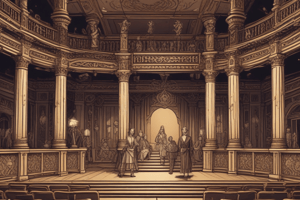Podcast
Questions and Answers
What do the traditional masks of drama represent?
What do the traditional masks of drama represent?
- Acting techniques
- Character development
- High and low comedy
- Comedy and tragedy (correct)
What defines a tragic hero in dramatic literature?
What defines a tragic hero in dramatic literature?
- They are typically invulnerable to conflict.
- They possess heroic qualities that lead to a downfall. (correct)
- They have a perfect moral compass.
- They always succeed in their endeavors.
Which of the following is NOT a conflict type in drama?
Which of the following is NOT a conflict type in drama?
- Person versus himself/herself
- Person versus technology (correct)
- Person versus God/universe
- Person versus group/society
Which structure in a play refers to the division of scenes?
Which structure in a play refers to the division of scenes?
What is the role of rising action in a drama?
What is the role of rising action in a drama?
What distinguishes high comedy from low comedy?
What distinguishes high comedy from low comedy?
What is meant by 'in medias res' in the context of drama?
What is meant by 'in medias res' in the context of drama?
What is a key characteristic of characters in a play?
What is a key characteristic of characters in a play?
What literary device involves addressing an object as if it were a real person?
What literary device involves addressing an object as if it were a real person?
What is the purpose of using hyperbole in literature?
What is the purpose of using hyperbole in literature?
Which of the following best describes an oxymoron?
Which of the following best describes an oxymoron?
What type of irony occurs when the audience knows more than the characters?
What type of irony occurs when the audience knows more than the characters?
Which literary device involves recurring sounds at the beginning of closely arranged words?
Which literary device involves recurring sounds at the beginning of closely arranged words?
What is a key characteristic of a euphemism?
What is a key characteristic of a euphemism?
How do men and women typically react to certain issues and events?
How do men and women typically react to certain issues and events?
What does the literary term 'climax' refer to?
What does the literary term 'climax' refer to?
What is the primary function of an allusion in literature?
What is the primary function of an allusion in literature?
What is a common misconception about how people in different social classes communicate?
What is a common misconception about how people in different social classes communicate?
What should be avoided in dialogue writing to maintain authenticity?
What should be avoided in dialogue writing to maintain authenticity?
In dialogue, how should characters typically interact?
In dialogue, how should characters typically interact?
What role does dramatic action play in a play?
What role does dramatic action play in a play?
What is a characteristic of a simile in literature?
What is a characteristic of a simile in literature?
How does one distinguish metaphor from simile?
How does one distinguish metaphor from simile?
How should a play's theme be conveyed to the audience?
How should a play's theme be conveyed to the audience?
Flashcards are hidden until you start studying
Study Notes
Tragedy
- The traditional symbol of tragedy is a sad mask.
- The tragic hero is fallible and their downfall is a result of their choices.
Comedy
- The word comedy comes from the Greek "komos," meaning a revel or celebration.
- Comedy is divided into "high" and "low" varieties.
- A regular comedy is a play of one to five acts.
- Plays are a genre of literature designed to be performed on stage.
Plot and Drama Structure
- The dramatic structure of a play refers to the plot.
- Plays are divided into acts.
- The plot revolves around a conflict: person versus self, another person, group, nature, or God/universe.
- The play's action and tension are built up to create an impact on the audience.
- The introduction can begin with the conflict immediately, called "in medias res."
- Hints of an impending conflict can be provided in the introduction.
Rising Action or Complication
- The rising action is the series of events that lead to the climax.
Turning Point, Climax, Crisis
- The turning point is the moment when the protagonist's fate is sealed.
Falling Action
- The falling action is the series of events that occur after the climax.
Denouement or Resolution
- The denouement is the final outcome of the play.
Tone in Drama
- The writer establishes the tone of a play through the use of language and character revelation.
Key Concepts
- Theme: The central idea or message of the play.
- Conflict: The central struggle in the play.
- Suspense: The feeling of anticipation and excitement created by the playwright.
Characters
- Characters must be well-developed and realistic.
- Characters should be portrayed authentically based on factors like gender, social class, age, education, marital status, occupation, and political beliefs.
Dialogue
- Dialogue is the primary component of a play.
- Dialogue should be realistic and reflect natural speech patterns.
- Avoid clichés, excessive use of character names, and long uninterrupted speeches.
- Theme should be conveyed through the events of the play, not through dialogue.
Dramatic Action
- Dramatic action defines a character's development from static to changing.
Figures of Speech and Imagery
- Simile: A comparison using "like" or "as."
- Metaphor: An implied comparison.
- Personification: Giving human qualities to inanimate objects or abstract concepts.
- Apostrophe: Addressing objects as if they were real.
- Hyperbole: Exaggeration for effect or humor.
- Oxymoron: Combining two contradictory words.
- Irony:
- Verbal: Saying the opposite of what is meant.
- Situational: The opposite of what is expected happening.
- Dramatic: The audience knows more than the characters.
- Alliteration: Repetition of initial consonant sounds.
- Onomatopoeia: Words that sound like what they describe.
- Metonymy: Substituting a word for another that signifies the same thing.
- Synecdoche: Using a part to represent the whole.
- Periphrasis: Using a descriptive phrase instead of a noun.
- Euphemism: Using a less offensive word for a harsh one.
- Climax: Arrangement of words or ideas in order of increasing importance.
- Anti-Climax: A decrease in importance of what is said, opposite to the climax.
- Antithesis: Balancing two opposing ideas.
- Pun: A play on words with humorous effect.
- Allusion: Reference to a literary, biblical, socio-political, scientific, or mythological event or character.
- Paradox: A contradictory yet true statement.
- Assonance: Repetition of initial vowel sounds.
- Anaphora: Repetition of words or phrases at the beginning of clauses or sentences.
- Visual: Creating a picture in words, something visualizable.
- Auditory: Creating sounds in the reader's mind.
- Olfactory: Creating smells in the reader's mind.
Studying That Suits You
Use AI to generate personalized quizzes and flashcards to suit your learning preferences.




